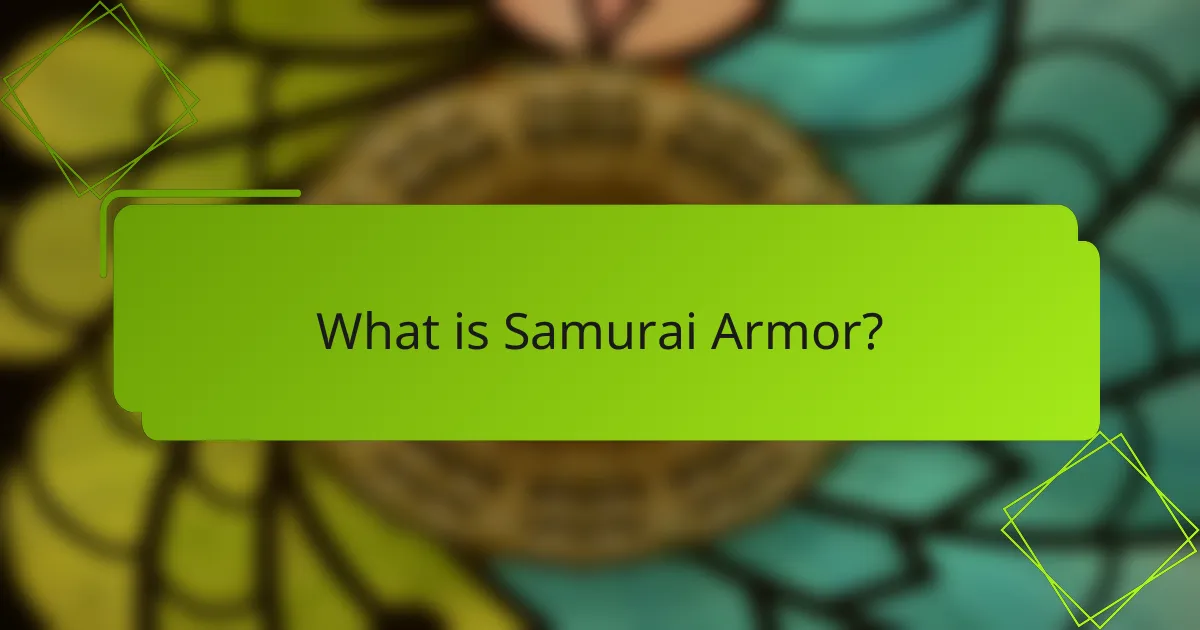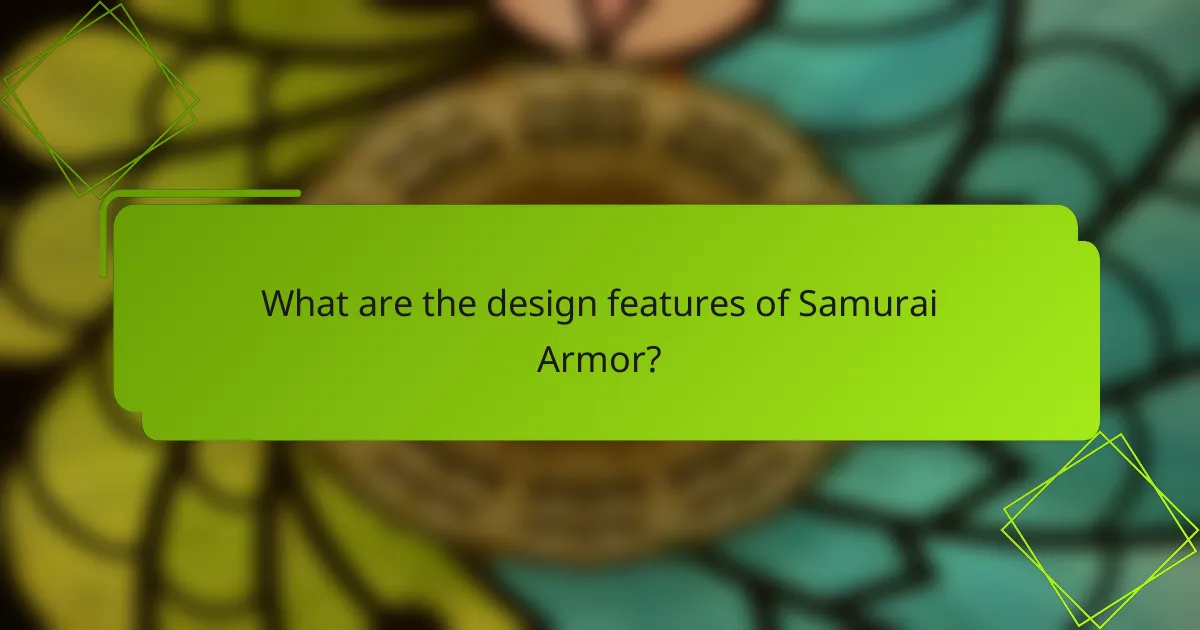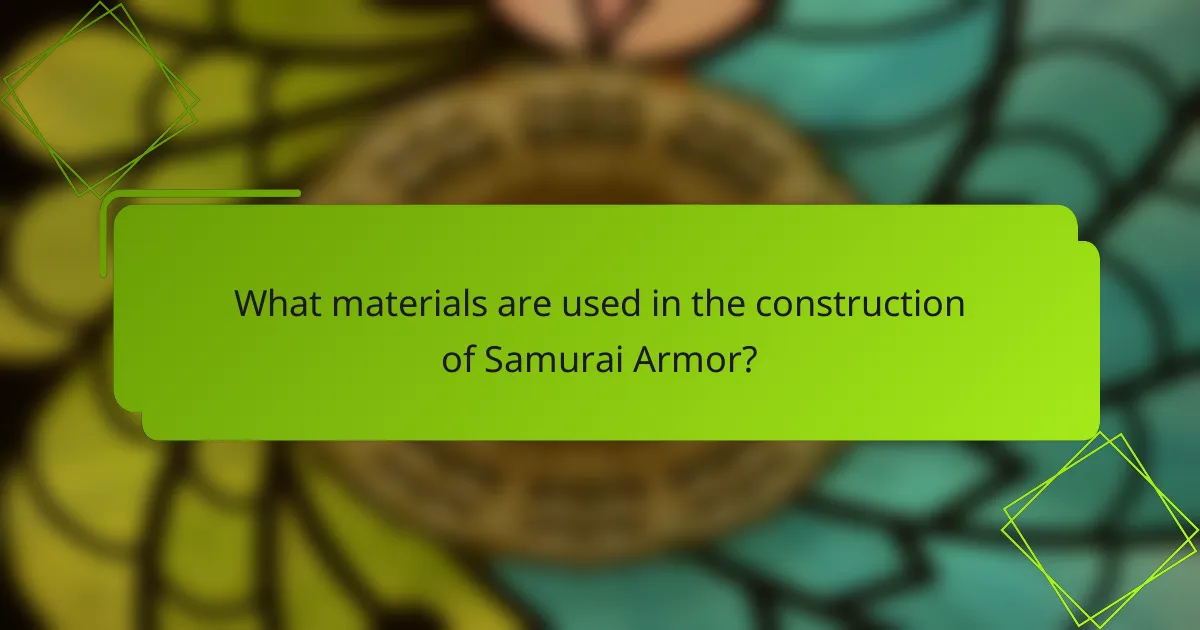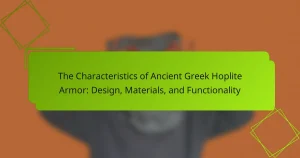Samurai armor, known as “yoroi,” is a traditional form of protective clothing worn by Japanese warriors called samurai. This armor is characterized by its layered construction, combining materials such as iron, leather, and silk, which provide both protection and mobility in battle. Key components include the kabuto (helmet) and do (chest armor), often adorned with intricate decorations and clan insignias, reflecting the samurai’s status and identity. The design of samurai armor has evolved over centuries, showcasing craftsmanship that is highly regarded in Japanese culture and adapting to changes in warfare and aesthetics. The article explores the cultural significance, design features, and materials used in samurai armor, highlighting its importance in both combat effectiveness and cultural expression.

What is Samurai Armor?
Samurai armor is a traditional form of protective clothing worn by Japanese warriors known as samurai. This armor, called “yoroi,” was designed for both protection and mobility in battle. It typically consisted of a combination of metal, leather, and fabric components. The armor featured distinctive elements, such as the kabuto (helmet) and do (chest armor). Samurai armor was not only functional but also a symbol of status and identity. Its design often included intricate decorations and clan insignias. Historically, samurai armor evolved over centuries, reflecting changes in warfare and aesthetics. The craftsmanship involved in creating this armor is highly regarded in Japanese culture.
How did Samurai Armor evolve over time?
Samurai armor evolved significantly from the 8th century to the 19th century. Initially, armor was made of leather and simple materials. By the 12th century, iron and steel became more common. This transition improved durability and protection. The design became more intricate, reflecting the samurai’s status. By the 16th century, armor featured elaborate decorations and unique shapes. The introduction of firearms in warfare led to changes in armor design. Samurai armor adapted to balance mobility and protection. By the Edo period, armor became more ceremonial, emphasizing aesthetics over battlefield functionality.
What historical events influenced the design of Samurai Armor?
The design of Samurai Armor was influenced by several historical events. The rise of the samurai class during the Heian period (794-1185) marked the beginning of specialized armor for warriors. The Genpei War (1180-1185) showcased the need for effective protection during battles. The Mongol invasions in the late 13th century prompted innovations in armor design to counter new weaponry. The Sengoku period (1467-1603) saw the introduction of more elaborate and decorative armor reflecting individual clan identities. The unification of Japan under Tokugawa Ieyasu in the early 17th century led to standardization in armor production. Additionally, encounters with Western firearms in the 16th century influenced the materials and construction methods used in armor. These events collectively shaped the evolution of Samurai Armor throughout Japanese history.
What are the key periods in the development of Samurai Armor?
The key periods in the development of Samurai armor include the Heian period, the Kamakura period, the Muromachi period, and the Edo period. The Heian period (794-1185) saw the initial emergence of armor styles influenced by Chinese designs. The Kamakura period (1185-1333) introduced more practical and functional designs due to the rise of the samurai class. The Muromachi period (1336-1573) featured the development of the iconic do (chest armor) and kabuto (helmet) designs. The Edo period (1603-1868) marked a time of peace, leading to ornate and ceremonial armor. Each period reflects the evolving needs and aesthetics of samurai warfare and culture.
What are the main components of Samurai Armor?
The main components of Samurai armor include the kabuto, do, sode, kusazuri, and kote. The kabuto is the helmet that protects the head. The do is the chest armor that shields the torso. Sode are the shoulder guards that provide additional protection. Kusazuri are the hanging plates that protect the lower body. Kote are the armored sleeves that cover the arms. Each component serves a specific purpose in providing protection during combat. Samurai armor was designed for both functionality and aesthetics, reflecting the warrior’s status.
What materials are traditionally used in Samurai Armor?
Samurai armor is traditionally made from materials such as iron, leather, and silk. Iron plates were used for their strength and durability. Leather provided flexibility and comfort. Silk was often used for lacing and decorative elements. Additionally, bamboo was sometimes incorporated for lightweight construction. These materials combined to create armor that was both functional and aesthetically pleasing. Historical records indicate that the use of these materials dates back to the Heian period in Japan. The craftsmanship of samurai armor reflects the warrior’s status and the artistry of the period.
How do the components of Samurai Armor work together for protection?
Samurai armor is designed with multiple components that work together to provide comprehensive protection. The helmet, or kabuto, shields the head and neck from strikes. The cuirass, known as do, covers the torso and is often reinforced to absorb impact. Sleeves, or kote, protect the arms while allowing for movement. The skirt, or kusazuri, extends from the cuirass to shield the thighs. Each component is crafted from materials like iron, leather, and silk, enhancing durability and flexibility. The layered construction disperses force, reducing injury risk. Historical records show that samurai armor was effective in battle, allowing warriors to engage in combat with confidence.
What cultural significance does Samurai Armor hold?
Samurai armor holds significant cultural importance in Japan. It symbolizes the warrior class and their code of honor, known as bushido. The armor represents not just protection in battle, but also status and artistry. Each piece was often uniquely crafted, showcasing the skill of the armorers. The intricate designs reflected the samurai’s clan and personal identity. Historically, samurai armor was worn during feudal conflicts, reinforcing its role in Japan’s military heritage. Today, it serves as a symbol of Japanese culture and history, celebrated in museums and festivals. The preservation of samurai armor highlights its lasting legacy in Japanese society.
How does Samurai Armor reflect the values of the Samurai class?
Samurai armor reflects the values of the Samurai class through its design and symbolism. The armor emphasizes honor, loyalty, and bravery. Each piece is crafted to protect while also showcasing the warrior’s status. The intricate designs often include family crests, signifying loyalty to one’s clan. The materials used, such as iron and leather, represent strength and resilience. Additionally, the armor’s functionality highlights the Samurai’s commitment to martial skill. Historical texts indicate that Samurai armor was not just protective gear but also a representation of the Samurai’s identity. This connection to cultural values is evident in the way armor is preserved and respected in Japanese history.
What role does Samurai Armor play in Japanese ceremonies and traditions?
Samurai armor plays a significant role in Japanese ceremonies and traditions. It is often used in cultural events to symbolize the warrior spirit and historical legacy of the samurai. During festivals, samurai armor is worn to honor ancestors and celebrate martial heritage. The armor represents values such as honor, loyalty, and bravery. It is also featured in traditional ceremonies, including weddings and tea ceremonies, where it signifies respect and cultural pride. The presence of samurai armor in these contexts reinforces the importance of martial traditions in Japanese culture. Historical records indicate that samurai armor was integral to the identity of the samurai class, influencing various aspects of Japanese society.

What are the design features of Samurai Armor?
Samurai armor is characterized by its layered construction and protective design. The armor typically features a combination of metal and leather components. These materials provide both flexibility and durability. The distinctive helmet, known as kabuto, often includes elaborate crests. The do, or cuirass, protects the torso and is often lacquered for weather resistance. Samurai armor also includes protective sleeves and shin guards. Furthermore, the armor is designed for mobility, allowing for swift movements in battle. Historical examples, such as the armor used in the Sengoku period, showcase these design features effectively.
What styles of Samurai Armor exist?
There are several styles of Samurai armor, known as “yoroi.” The primary styles include the O-yoroi, which is characterized by its large, elaborate design and was popular among high-ranking samurai. Another style is the Do-maru, which features a more streamlined design, allowing for greater mobility. The Haramaki style is a simpler form of armor that offers flexibility and ease of movement. The Tachi-yoroi is designed for cavalry use, featuring a long skirt and additional protection for the legs. Each style reflects different combat needs and social status among samurai. Historical records show these variations evolved over centuries, adapting to changes in warfare and technology.
How do different styles of Samurai Armor vary by region?
Different styles of Samurai armor vary significantly by region, reflecting local materials and cultural influences. For example, the armor from the Kanto region often features a more elaborate design with intricate lacquer work. In contrast, armor from the Kansai region tends to be more practical and utilitarian, focusing on functionality over decoration. The northern regions, such as Tohoku, utilized heavier materials to provide additional protection against harsh climates. Similarly, the southern regions often favored lighter armor for increased mobility in combat. Each regional style showcases unique attributes, such as specific helmet shapes or shoulder guards, which are tailored to local warfare practices. Historical documents indicate that these variations were influenced by the type of battles fought and the available resources.
What are the unique attributes of specific Samurai Armor types?
The unique attributes of specific Samurai armor types include distinct designs, materials, and protective features. The O-yoroi armor is characterized by its large shoulder guards and a broad chest plate. This design provided excellent protection for mounted warriors. The Do-maru armor is lighter and more flexible, allowing for greater mobility. It typically features a simpler design with a single breastplate. The Tachi armor is notable for its long sleeves and additional protection for the arms. This type was favored by foot soldiers. Each armor type reflects the specific needs of the samurai’s combat style and social status. The variations in construction and decoration also indicate the armor’s owner and their rank. Historical records show that different regions in Japan had unique styles, further diversifying Samurai armor types.
How does the design of Samurai Armor enhance functionality?
The design of Samurai Armor enhances functionality through its structured layers and mobility features. The armor typically consists of multiple parts, including the do (chest armor), kabuto (helmet), and sode (shoulders). Each component is crafted to provide protection while allowing for agility in battle.
The overlapping plates, known as kusazuri, enable flexibility and movement. This design allows samurai to engage in combat without sacrificing mobility. Additionally, the use of lightweight materials, such as iron and leather, helps reduce fatigue during extended battles.
Historical records indicate that Samurai Armor was developed over centuries to adapt to various combat styles. The intricate design not only provided physical protection but also served as a status symbol. This dual purpose underscores the effectiveness of the armor in both functionality and cultural representation.
What ergonomic features are incorporated into Samurai Armor design?
Samurai armor incorporates several ergonomic features designed for mobility and protection. The armor is constructed with overlapping plates, allowing flexibility while maintaining defense. It features a lightweight design to reduce fatigue during combat. The arrangement of the armor plates is tailored to the body’s natural movements. This design minimizes restriction of motion, enabling swift actions. Additionally, the armor includes adjustable straps for a secure fit. These straps allow for quick adjustments during battle. The helmet design often includes a wide brim for visibility and protection from strikes. Overall, these ergonomic features enhance the samurai’s effectiveness in combat scenarios.
How does the design of Samurai Armor accommodate mobility in battle?
The design of Samurai Armor accommodates mobility in battle through its segmented construction. This segmented design allows for greater flexibility and ease of movement. Each piece of armor, such as the do (chest armor) and sode (shoulder guards), is articulated. Articulation enables the wearer to bend and twist without restriction. Additionally, the materials used, like leather and metal, are lightweight yet durable. This balance of protection and mobility is critical for combat effectiveness. Historical accounts show that Samurai could perform agile maneuvers while wearing this armor. Such design principles were essential for the dynamic nature of battlefield tactics during the feudal era.

What materials are used in the construction of Samurai Armor?
Samurai armor is primarily constructed from materials such as iron, leather, and silk. Iron plates are used for their strength and protection against weapons. Leather is often employed for flexibility and comfort. Silk cords are utilized to bind the armor pieces together. Additionally, lacquer is applied to enhance durability and weather resistance. These materials combine to create a functional and aesthetically pleasing form of protection for samurai warriors. Historical records indicate that the use of these materials was essential for both combat effectiveness and cultural expression in samurai armor design.
What are the traditional materials used in Samurai Armor production?
Traditional materials used in Samurai armor production include iron, leather, silk, and lacquer. Iron was primarily used for the construction of plates and helmets. Leather provided flexibility and comfort in armor design. Silk was often used for lacing and decorative elements. Lacquer was applied for protection against moisture and to enhance aesthetics. These materials contributed to the armor’s durability and functionality. Historical records indicate that the combination of these materials allowed for both protection and mobility in battle.
How does each material contribute to the overall effectiveness of Samurai Armor?
Samurai armor is composed of various materials, each contributing to its overall effectiveness. Iron plates provide durability and protection against weapons. Leather offers flexibility and comfort, allowing for ease of movement. Silk lacing secures the armor and adds resilience against wear. Wood components enhance structural strength while remaining lightweight. Cotton padding absorbs shock and increases comfort during battle. These materials combined create a balance of protection, mobility, and comfort, essential for a samurai in combat. Historical records show that the use of layered materials improved survivability on the battlefield, demonstrating their effectiveness.
What modern materials are being used in replicas of Samurai Armor?
Modern replicas of Samurai Armor utilize materials such as fiberglass, carbon fiber, and synthetic leather. These materials are chosen for their durability and lightweight properties. Fiberglass offers strength while being easier to mold into intricate designs. Carbon fiber provides an even lighter option with high tensile strength. Synthetic leather is used for its weather resistance and ease of maintenance. Some replicas also incorporate advanced textiles for comfort and flexibility. These modern materials allow for a balance between authenticity and practicality in wearability.
What is the process of creating Samurai Armor?
The process of creating Samurai armor involves several meticulous steps. First, artisans select high-quality materials like iron, leather, and silk. Then, they craft individual components such as the do (chest armor), kabuto (helmet), and sode (shoulders). Each piece is shaped using traditional forging techniques. Artisans often employ lacquer to protect the armor from rust and wear. After shaping, they assemble the components using cords and lacing for flexibility. Decorative elements, such as family crests, are added for personalization. Finally, the armor undergoes rigorous testing for functionality and durability. Historical records show that this craftsmanship was essential for both protection and status in feudal Japan.
How are the materials prepared and treated for armor-making?
Materials for armor-making are prepared through specific processes that enhance their durability and effectiveness. First, metals such as iron or steel are sourced and shaped into plates. These plates undergo heating to improve their malleability. After heating, they are hammered or pressed into the desired form.
Leather, another common material, is tanned to increase its strength and resistance to wear. The tanning process involves soaking the leather in tannin-rich solutions. Natural fibers like silk are often woven tightly to ensure flexibility and strength.
Once materials are shaped, they are often coated with lacquer for additional protection. This lacquer seals the surface and provides a waterproof barrier. The final assembly involves stitching or riveting the pieces together to create a cohesive armor structure.
Historical records indicate that these methods were refined over centuries, resulting in highly functional and aesthetically pleasing armor.
What skills are required in the craftsmanship of Samurai Armor?
The craftsmanship of Samurai armor requires several specialized skills. These include metalworking, leatherworking, and textile crafting. Metalworking is essential for shaping and assembling the armor plates. Leatherworking is crucial for creating straps and fittings that secure the armor. Textile crafting is necessary for producing the undergarments and decorative elements.
Additionally, knowledge of historical techniques is important for authenticity. Attention to detail ensures the armor’s functionality and aesthetic appeal. Mastery of these skills has been passed down through generations of artisans. Historical records indicate that skilled craftsmen were highly respected in samurai culture.
What are the best practices for maintaining Samurai Armor?
To maintain Samurai Armor effectively, it is essential to clean it regularly. Use a soft cloth to remove dust and dirt after each use. Avoid harsh chemicals that can damage the materials. For metal parts, apply a thin layer of oil to prevent rust. Store the armor in a cool, dry place to avoid moisture buildup. Inspect the armor for any signs of wear or damage frequently. Repair any issues promptly to preserve its integrity. These practices help maintain the armor’s condition and longevity, reflecting its historical significance.
How should Samurai Armor be cleaned and stored to preserve its condition?
Samurai armor should be cleaned with a soft, dry cloth to remove dust and moisture. Avoid using water or cleaning solutions, as they can damage the materials. For more thorough cleaning, use a specialized leather conditioner on leather parts. Store the armor in a cool, dry place away from direct sunlight to prevent fading and deterioration. Use a protective cover or box to shield it from dust and physical damage. Regularly inspect the armor for signs of wear or damage to address any issues promptly. Proper storage helps maintain the integrity of the materials, ensuring the armor remains in good condition over time.
What common issues can arise with Samurai Armor, and how can they be addressed?
Common issues with Samurai Armor include deterioration, misalignment, and damage from impacts. Deterioration occurs due to age and environmental factors. Regular cleaning and proper storage can mitigate this issue. Misalignment can happen from improper fitting or wear. Adjusting straps and fittings can help maintain proper alignment. Damage from impacts can result in dents or cracks. Professional restoration can effectively address this type of damage. Additionally, rust can develop on metal components. Applying protective coatings can prevent rust formation. Overall, regular maintenance and professional care are essential for preserving Samurai Armor.
Samurai armor, known as “yoroi,” is a traditional protective clothing worn by Japanese warriors, characterized by its intricate design and cultural significance. The article explores the evolution of samurai armor from the 8th to the 19th century, highlighting key historical events and periods that influenced its design, such as the Heian and Edo periods. It details the main components, materials, and styles of armor, emphasizing their functional and aesthetic attributes. Additionally, the article discusses the craftsmanship involved in armor-making, maintenance practices, and the cultural values reflected in samurai armor, illustrating its lasting legacy in Japanese history.



